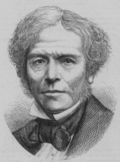Pages 580-591
This page-by-page annotation is organized by sections, as delineated by the seven squares (sprockets) which separate each section. The page numbers for this page-by-page annotation are for the original Viking edition (760 pages). Editions by other publishers vary in pagination — the newer Penguin editions are 776 pages; the Bantam edition is 886 pages.
Contributors: Please use a 760-page edition (either the original Viking edition with the orange cover or the Penguin USA edition with the blue cover and rocket diagram — there are plenty on Ebay for around $10) or search the Google edition for the correct page number. Readers: To calculate the Bantam edition use this formula: Bantam page # x 1.165. Before p.50 it's about a page earlier; as you get later in the book, add a page.
Finally, profound thanks to Prof. Don Larsson for providing the foundation for this page-by-page annotation.
Page 582
582.05 the same Pflaumbaum
See 159.37-38. We now learn that the "Jewish wolf" was really a victim, who could never have collected on fire insurance even if he had wanted to, and who wound up in a concentration camp. Note the suggestion that Lyle Bland himself was responsible for the fire.
Page 584
584.40 portrait of Michael FaradayAlthough Weisenburger does not find a listing for a portrait of Faraday in the 1967 Tate catalogue, there are portraits of the scientist at the National Gallery and the National Portrait Gallery in London. Pictures and daguerreotypes of the older Faraday do seem to convey some of the menace suggested in the narrator’s description of Tantivy’s reaction on pages 584-585. Pynchon's (or Tantivy's?) characterization is probably unfair, since Faraday belonged to a small Christian sect that tried to live by the principles of the Sermon on the Mount.
Page 584
584.13 forest of Arden
Weisenburger does not see much relevance to the reference to Shakespeare’s pastoral retreat in As You Like It, but the context does fit here, ironically. The scene of bucolic refuge in the play is now a scene of death after the Battle of the Bulge, where the bodies lie "gangrenous in the snow."
Page 586
586.1-11 All the baggy-pants outfielders . . . Olympic runners
All types of characters seen on pinball scoreboards (as are the can-can dancers at 584.19).
The Silver Streak was a comic book superhero of the early 1940s, published by Lev Gleason. His comic book also featured a racistly depicted Oriental giant with fangs and long nails, known as The Claw (usually opposed the original Daredevil; The Claw himself was popular enough to become one of the few super-villains with his own comic book). In 1942, the comic was renamed Crime Does Not Pay. See note at 709.15. However, David Erickson adds the following reference:
- "I always thought the reference was to Fibel's arriving in a hurry: The Silver Streak was the nickname of the Pioneer Zephyr, a streamlined train built for the Chicago, Burlington, and Quincy Railroad and entered into service in 1934. It set the rail land speed record on May 26, 1934, running from Denver to Chicago in just over 13 hours."
- The Silver Streak was a 1934 film loosely based on the record-setting "dawn-to-dusk" run of the Pioneer Zephyr on May 26, 1934.
. The Chicago Museum of Science and industry has a very good website about the train.
Page 587
587.08 General Electric plant in Pittsfield, Massachusetts
Another reference point initially lifted from The Berkshire Hills, p. 80. The book’s authors note that the plant was at the time the leading manufacturer of transformers and specifically mention the "new million-dollar Plastics Department, where finished parts for radios, refrigerators, and oil heating units are manufactured from raw materials..."
Page 591
591.18 Buddy left to see The Bride of Frankenstein
Contrary to Weisenburger, Buddy probably did see the film. This is the day of Lyle Bland’s Transcendence; Buddy goes to see Dracula instead of going to the funeral, which is presumably some days later. See note at 645.12.
| 1 Beyond the Zero |
3-7, 7-16, 17-19, 20-29, 29-37, 37-42, 42-47, 47-53, 53-60, 60-71, 71-72, 72-83, 83-92, 92-113, 114-120, 120-136, 136-144, 145-154, 154-167, 167-174, 174-177 |
|---|---|
| 2 Un Perm' au Casino Herman Goering |
181-189, 189-205, 205-226, 226-236, 236-244, 244-249, 249-269, 269-278 |
| 3 In the Zone |
279-295, 295-314, 314-329, 329-336, 336-359, 359-371, 371-383, 383-390, 390-392, 392-397, 397-433, 433-447, 448-456, 457-468, 468-472, 473-482, 482-488, 488-491, 492-505, 505-518, 518-525, 525-532, 532-536, 537-548, 549-557, 557-563, 563-566, 567-577, 577-580, 580-591, 591-610, 610-616 |
| 4 The Counterforce |
617-626, 626-640, 640-655, 656-663, 663-673, 674-700, 700-706, 706-717, 717-724, 724-733, 733-735, 735-760 |


